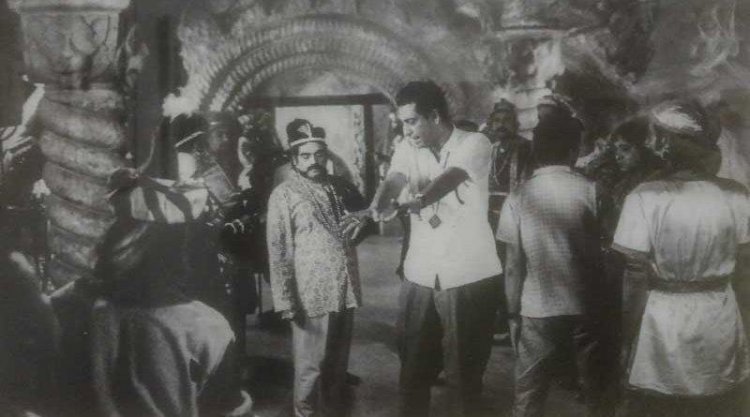50 years later the many lessons of the ‘Goopy Gyne Bagha Byne’ trilogy continues to remain relevant

An unconventional tale about art being the central factor of life took shape half a century ago, and today it is more than a necessity for a generation on the brink of moral crisis.
A singer who has not the least idea about notes and chords meets a drummer who is deaf when it comes to rhythm and beats. Together they are blessed by the a so-called Bhooter Raja (Ghost King) who grants them three boons- the ability to have anything by simply clapping their hands, the capacity to travel anywhere with a pair of magic slippers, and the ultimate blessing to literally pause all movement with their song. Such was the prolific consequence of Satyajit Ray’s movie for children, which in spite of spanning for almost five decades continues to remain prevalent in the contemporary society.
Ray already had 13 well known movies to his name when he worked on ‘Goopy Gyne Bagha Byne’. Adapting from his grandfather, Upendrakishore Ray Chowdhury’s comic which had appeared in the ‘Sandesh’ magazine, back in 1915, Ray revolutionized the art of filmmaking in Bengal. However, soon the movie attained a kind of greeting from both audience and critics which was never seen before. Ray had chiefly helmed the film as perhaps a gift to his son, Sandip Ray, who would often ask his father to make movies that weren’t only dealing with adult topics. Hence, Ray brought up every possible abstract character such as tone deaf musicians, monopoly of ghosts, and fictional villages that served as the perfect breeding ground for characters as amiable as Goopy and Bagha.
Although Ray was compelled to satiate his needs of a fantasy tale in black and white shades, it wasn’t long before the movie became a sensation in film industry worldwide. The sheer inclination towards anti-war themes, caste system and parody of the social structure gave it the stature of a piece of art that would surpass the limitations of time. The film gained such massive attention that it was necessary for Goopy and Bagha to set out on a journey that would have a proper conclusion, and it all began with ‘Goopy Gyne Bagha Byne’ in 1969. The tone deaf musicians, after being gifted by the King of Ghosts, set out on a journey to Shundi where they win over the ruler with their now heart warming tunes. However, soon the impending doom of the King of Halla falls upon them and the musical duo manage to put an end to what might be called a civil war by the sheer power of music.
The musical duo’s journey became a symbol of social issues. (IMDb)
Although Ray himself has never directly addressed to the theme, many believe that it was one of his ways of claiming that art and humane moral can easily overcome any war. Ray’s anti-war message extended to the sequel, ‘Hirok Rajar Deshe’, which was even clearer in its representation of social issues. We come across the tyrannical rule of a king and the struggling affair of a teacher who wants his students to stand up against the ruler. The entire movie orbits around the timeless struggle of the oppressed to topple the suppressor who by every mean is a definite threat to humankind. Unlike the first film, Goopy and Bagha are not the heroes but the observers here. Released in 1980, this was the time when the nation would plunge in what would be its industrial revolution and the rise of insurgency in Punjab, the film served as the perfect representation of the jeopardy that the nation was pushed into. Hirok Raja was defeated by those whom he tried to keep in the dark by brain washing them, and four years later Indira Gandhi is assassinated by her bodyguards after she suppressed the country in the Emergency.
The last movie in the franchise was less bold but equally revolting in its aspect. ‘Goopy Bagha Fire Elo’, released in 1992, saw two reluctant musicians leave behind their royal luxuries and return to the road where they once again are given the opportunity to relive their youth. However, the film takes a more idealistic turn when the duo is advised by Bhooter Raja to not dabble with the course of time. Unlike the former two this movie comes to a more conclusive end where all evil fades away and the good remain to carry on with life.
The final movie took a more moralistic approach. (IMDb)
The three stories put together gives a crystal clear view of the life that we lead. Firstly, it does not matter how pathetic you are with your art as long as you manage to utilize it in the perfect way to serve humanity. Secondly, you don’t always have to be the hero of your own story and sometimes you ought to use your influence to fulfil someone else’s dream. Thirdly, let life take its course and everything will fall back in place- does not matter if you are there to see it or not. Such was the timeless teaching of what was initially supposed to be a children’s tale. Ray’s cinematography revolutionized storytelling onscreen and his sheer ingenuity continues to baffle us even today.















































